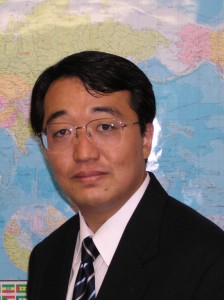緊張と統合:内村鑑三におけるキリスト教と日本の精神
このシリーズでは、私が1994年に執筆した統一神学大学院(Unification Theological Seminary)の神学課程修士論文(Divinity Thesis)を日英二か国語で掲載している。
4.日本文化とキリスト教の統合の続き
C.神道と禅宗
カルロ・カルダローラは、無教会の信仰に見られるキリスト教に対する神秘実存主義的なアプローチは、鋭い直観と強烈な霊的体験を典型的な特徴としており、日本の宗教的伝統との間に連続性が見出されると論じている。日本の宗教生活においては、全ての偉大な宗教伝統が、国家および家庭次元において示され、ほとんど分離し難いほどに融合していた。儒教と神道は、仏教の形而上学および心理学を借用し、仏教と神道は、儒教の倫理学から多くを借用した。そして儒教と仏教は完全に日本化されてしまった。
神道は、態度と生活様式の両面において日本文化に浸透している。日本人の大部分は、神道が彼らの生活をどの程度支配しているかに対して無頓着であるが、それは日本人の霊性の本質を特徴付ける最も基本的な方向性を与えているのである。「神道的方法」は、外国の思想や宗教を日本に土着化させる時の、主要な起動力として働いてきた。その直観的な性質と日本人の精神性における形成力の故に、神道は輸入されて来た教えに対して挑発的・挑戦的に立ち向かうことよりも、むしろ粘り強くそれを取り込んで行くことによってその目的を果たして来たのである。神道には自意識的な表現が欠如していることが、日本人の精神を形式化から自由にし、それによって日本人は、外国の哲学の複雑な理論から土着の傾向と共存し得る要素を抽出することができたのである。仏教と儒教が日本において経験した著しい変容は、この様な土着化の力学の最も顕著な例のうちに数えることができる。
日本の禅宗は、神道版の仏教とみなすことができるであろう。禅宗の意図は、人間を生命との一致へと導くことにある。この合一により、人は彼の外部にある全ての存在からの疎外を克服し、自己と他者の間のいかなる相克をも超越する。禅とは主観と客体を超越した「純粋存在」に気付くことであり、存在を「如」(そのまま、そのごとく)において直接に把握することである。この認識の特徴は、思索的でなく、意識的でなく、哲学的でも神学的でもないことである。それは心理学的観察や形而上学的思索の領域を越えた感覚なのであり、「実存的な意識」なのである。禅においてはこの合一はあらゆる形態の生命と直接一つとなることであるが、無教会においては基本的にそれは生命の源泉である神の霊との一体化である。それを通して人はあらゆる理性を越えた知恵、すなわち個々の状況において何が正しいかという実存的な直観を見出すのである。
禅は「プロセス」や何らかの特定の真理を「教える」ことを主張せず、公式の信条も、儀式も、道徳律も、教理要項も、教会組織も存在しない。禅は個人に真の自己を発見させ、彼を「真正の」生活に目覚めさせようと試みるだけである。これらの禅一般における典型的な感覚は、伝統的な日本のエートスの重要な側面を形成したのである。禅は公式的には極く小数の日本人によって実践されたに過ぎないが、それにもかかわらず禅の精神は、最も純粋な神道の精神と完璧に混じりあって、日本的な思考法のまさに核心に位置し、日本人の宗教性の独特な様相に貢献しているのである。
この宗教性の中心的要素は『誠』の態度であり、この言葉は英語においては普通はtrue, truthful, faithful, unselfish, pure, honest などと訳され、調和した心の性質のことを意味している。本質的に『誠』は「純粋な心」と「正直」を意味している。それは人が何ものも避けたり無視したりすることなく、全身全霊で人生に向かうことを示している。この概念は、全てにおいて清浄に対する崇敬を強調した古神道の伝統において最初に生じたものである。
IV. Synthesis of Japanese Culture and Christianity(Cont.)
C. Shinto and Zen Buddhism
Carlo Caldarola argues that the mystico-existential approach to Christianity in the Mukyokai faith, which is typically marked by a sharp sense of intuition and intense spiritual experience, is found to be in continuity with the religious tradition of Japan.(24) In the religious life in Japan, all the great religious traditions were represented and almost inseparably fused in the national and family level. Confucianism and Shinto had borrowed Buddhist metaphysics and psychology; Buddhism and Shinto had borrowed much of Confucian ethics; and Confucianism and Buddhism had been rather thoroughly Japanized.(25)
Shinto permeates Japanese culture as both attitude and life style. Although the vast majority of Japanese remain unaware of the extent to which Shinto dominates their lives, it provides the most basic orientation that characterizes the essence of Japanese spirituality. The “Shinto Way” has operated as a major impetus in the indigenization of foreign ideas and religion in Japan. Because of its intuitive nature and formative power in the Japanese mentality, Shinto has been a silent and invisible force which has attained its ends more by persistence than by provocative and challenging confrontations with the imported doctrines. Shinto’s lack of self-conscious expression has kept the Japanese mind free of formalization and therefore ready to abstract from the theoretical complexities of foreign philosophies those elements which are compatible with the indigenous tendencies. The remarkable transformation which Buddhism and Confucianism underwent in Japan are among the most outstanding examples of this indigenizing dynamic.(26)
Japanese Zen Buddhism can be regarded as the Shintoist version of Buddhism. The intention of Zen Buddhism is to bring man into oneness with life. In this union, man overcomes his alienation from everything outside himself and transcends any opposition between self and other. Zen is the awareness of “pure being” beyond subject and object, an immediate grasp of being in its “suchness” and “thusness.” The peculiarity of this awareness is that it is not reflective, not self-conscious, not philosophical nor theological. It is a sense beyond the realm of psychological observation and metaphysical reflection. It is an “existential consciousness.” (27) In Zen this union is directly with life in all of its forms; in the Mukyokai this union is primarily with God’s spirit, the very source of life, through which one finds a wisdom that transcends all reasoning, an existential intuition of what is right in each situation.(28)
Zen does not claim to “process” and to “teach” any particular truth, has no formal creed, no ritual, no moral code, no catechism, no church organization. Zen attempts only to enable the individual to discover his true self and to awake him to “authentic” life. These feelings, typical of Zen in general, form a relevant aspect of the traditional ethos of Japan. Although Zen is formally practiced by only a few score of Japanese, nevertheless the spirit of Zen, which perfectly blends with the most genuine Shinto spirit, is at the very core of the Japanese way of thinking and contributes to the unique features of Japanese religiosity.(29)
The central element of this religiosity is the attitude of makoto, a word which is usually translated as “true” – truthful, faithful, unselfish, pure, honest – and refers to the corresponding dispositions of the heart. In essence, makoto stands for “pure heart” and for “honesty.” It indicates that one approaches life with all one’s heart, shunning and neglecting nothing. This concept first arose in the old Shinto tradition which emphasized reverence for purity in all things.(30)
(24)op cit, Caldarola, p.20.
(25)op cit, Bellah, p.59.
(26)op cit, Caldarola, p.212-3.
(27)Ibid., p.84.
(28)Ibid., p.99.
(29)Ibid., p.85.
(30)Ibid., p.86.
